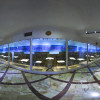
Holy Shrine Museum (Astan-e-Moghadase)
In 1314 S.H. a building in the name of museum was constructed in the west side of feminine courtyard in order to keep, conserve and publicly exhibit the precious objects of Hazrat Masoumeh Holy Shrine at the ministry of Islamic studies and endowments’ command. The place of museum was previously a building named Farsh Khaneh (literary meaning a house for carpets) which underwent total changes and repairs inside and outside the building when it was decided to use as a museum and based on the French architect and archaeologist’s order, Andre Godard, and under the supervision of Abulghasem, the ministry’s architect.
Constructing the façade building of the museum was carried out by Ostad Hasan Banna. The museum activity continued until 1353 S.H. and from then to 1361 S.H. it was temporary closed for different reasons such as the necessity of extending the peripheral spaces of the museum and establishing the current building. After 1361 S.H., the ongoing activity of museum was started. The museum basement with 500meters area was added to the previous building in 1371 S.H. and therefore, the total area reached to 1000m2. However, given to the plenty of items in collection, the current building lacked the capacity for existing materials and it is why a half of works did not have a chance to be visited
The collection houses more than 6000 artistic and historic items and the museum includes more than 20 sections: the oldest objects are kept in a sector dedicated to the first and the second millennium B.C., however, most of the museum works are related to Islamic era. A section for the manuscript Qurans related to a time span between 2th century A.H. to the contemporary period, handwritten books (historic, literary, moral), coins of pre-Islamic and Islamic periods, miniature and painting tableaus, the precious tableaus of calligraphy and gilding, inlay and embroidered works, pottery wares related to the first and second millennium B.C. and Islamic period, Chinese and glass wares, luster tiles with beautiful motifs and inscriptions related to the centuries of 6th to 8th A.H., relief and decorative stones, metal objects with etching decorations, Safavid and Qajar handwoven silk carpets and rugs as well as handwoven fabrics are the most important parts and items kept in the museum. Moreover, different kinds of Iranian and foreign stamps and the collection of sea creatures constitutes other parts of this museum.